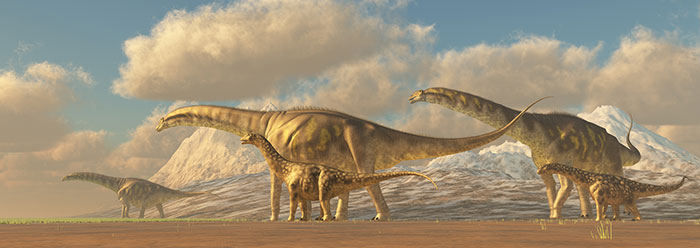Scientists described a new and remarkable fossil skeleton of a giant titanosaur, a group that includes the largest creatures ever to have lived on land. Dinosaur enthusiasts of all backgrounds want to know how big it was and what it may have looked like. Because this specimen is nearly 45 percent complete, it gives more details than any other fossil of its kind, as well as some details that confirm the biblical creation model.
This specimen was so large that probably nothing could stand in its way or even threaten it. For this reason, the researchers publishing in the journal Scientific Reports named it Dreadnoughtus schrani, after the Old English word "dreadnaught" which means "fear nothing."1
The titanosaurs include more than ten named species, all running for the title of "Biggest Dinosaur Ever." The Alamosaurus, Argentinosaurus, and Futalongosaurus are all listed among the ranks of giant dinosaurs. Owning the most complete bone kit of this group, the Dreadnoughtus specimen includes most of its tail, all of its hip bones, and many ribs and leg bones. Scientists recovered over 45.3 percent of its skeleton, including nearly 70 percent of the body bones other than its head. For comparison, Futalongosaurus comes in a distant second at only 26.8 percent complete.
And none of the huge bones were misshapen or out of place. In other words, the Dreadnoughtus skeleton looks like it was expertly crafted—obviously created—with none of the half-formed features that one would expect evolution to have left in its eons-long wake.
The study authors estimated its total body length at over 85 feet. But it may not have been fully grown! They noted what they called "remarkable" clues of youth, including shoulder bones that had not yet fused together.1 Prior finds, like Argentinosaurus, came from individuals that were even larger than Dreadnoughtus, though not as complete. Perhaps those finds represent the more mature adult creature Dreadnoughtus would have become if it had continued growing.
How could Noah have squeezed two Dreadnoughtus individuals onto the Ark? Many object to this notion, asserting that the Ark must have been too small for such great creatures. But even titanosaurids hatched from an egg only about six inches in length.2
Still anatomically young at 85 feet, this creature could have been growing for a long time, growing quickly, or both. Either way, a smaller and younger juvenile would have fit on the Ark just fine, as amply demonstrated in the book Noah's Ark: a Feasibility Study.3
And what about the dozen or so different titanosaurid names? Would two of every species have boarded the ark? Noah probably took on only two of the titanosaur kind. Who knows how long their descendants lasted after the Ark landed, but they probably all went extinct long ago.4
The researchers estimated Dreadnoughtus weighed a whopping 130,700 pounds, which is about the same as a dozen African elephants. How did a creature of such size turn into a fossil? Somehow its whole body was entombed in sediment—and quickly. However fast that watery sediment was flowing, it must have generated enough force to crush the giant dinosaur's body and dismember and scatter its head and feet. Perhaps Dreadnoughtus really feared nothing—until it saw the great Flood waters. USA Today wrote, "Some 80 million years ago, a raging torrent swept away two Dreadnoughtuses—perhaps already dead—before dumping them on a bed of quicksand-like sediment."5
A muddy tidal wave inundating an elephant herd-sized dinosaur fits the Flood. And like the well-formed anatomy of an elephant, that of Dreadnoughtus reminds the thoughtful observer that dinosaurs were created, just like in Genesis.
References
- Lacovara, K. J. et al. 2014. A Gigantic, Exceptionally Complete Titanosaurian Saruopod Dinosaur from Southern Patagonia, Argentina. Scientific Reports. 4 (6196).
- Chiappe, L. M., and L. Dingus. 2001. Walking on Eggs. Scribner: New York, NY.
- Woodmorappe, J. 1994. Noah's Ark: a Feasibility Study. Institute for Creation Research: Dallas, TX.
- Actually, Scripture may supply a clue to the timing of sauropod extinction post-Flood. Job witnessed behemoth, a creature so large that it did not fear a raging river and was called chief of the ways of God. Plus, it had a tail that looked like a cedar tree. If Job was looking at a sauropod dinosaur, then they did survive for at least 350 years after the Flood, the time of Abraham and Job. See: Thomas, B. 2013. Dinosaurs and the Bible. Institute for Creation Research, Dallas, TX.
- Watson, T. New 'massive' dinosaur skeleton discovered. USA Today. Posted on usatoday.com September 4, 2014, accessed September 5, 2014.
* Mr. Thomas is Science Writer at the Institute for Creation Research.
Article posted on September 8, 2014.




















